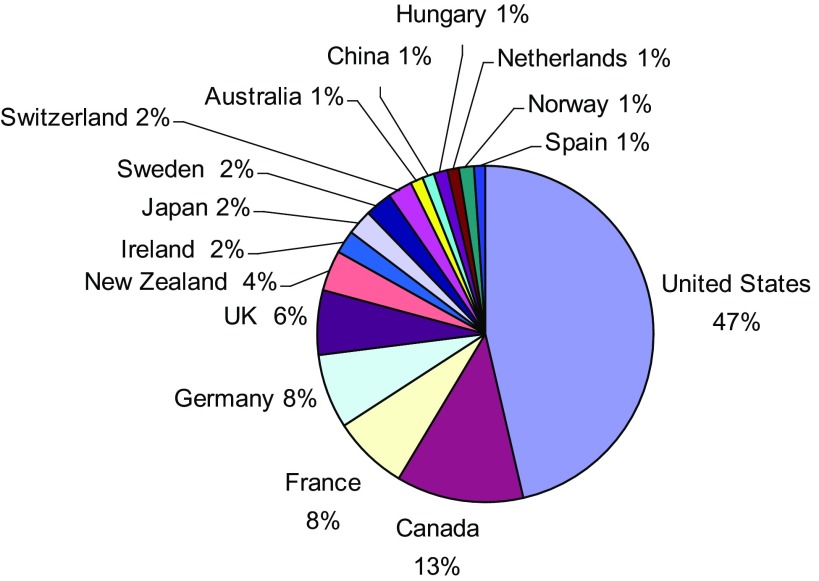The Darwin year 2009 witnessed a very good start in GBE’s first 12 months of operation. We received 136 submissions in the first year; our acceptance rate was 44%. On a per article basis, usage as measured in full-text or PDF downloads at GBE was excellent, comparable to other leading journals in the field. During 2010 the rate of new submissions at GBE was slightly up, relative to 2009, with an acceptance rate remaining steady as well. Gratifyingly, submissions by country (Fig. 1) show that GBE has been uniformly embraced by the field in North America, in Asia, and in Europe, consistent with the international nature of the society that owns the journal, the Society for Molecular Biology (SMBE).
FIG. 1.—
Submissions to GBE by country 2009–2010.
GBE was rapidly indexed in PubMed and in ISI. The journal is registering citations, which is another indication that it has been immediately embraced by the field. Manuscript handling times currently average five weeks from submission to first decision. A good mark, though, one that can still be improved upon.
Overall, things in the first two years of operation are going almost exactly according to plan. Our projections anticipated 30 published papers in 2009 (we published 47) and 60 in 2010 (we have published 65 through October 10), so we are meeting and exceeding our initial expectations.
The first 20 months of operation already witnessed some important changes. Among them is the newly designed page layout implemented early in 2010. We hope that authors and readers have found this to be an attractive addition to the Journal.
In addition, starting in the fall of 2010, we introduced the new Genome Reports section at GBE. Genome Reports will be focused papers of approximately 1500 words that publish the main evolutionary message of new genome sequences as they become submitted to GenBank. Nearly every new genome sequence effort harbors an important advance in evolutionary understanding. The Genome Reports section at GBE is the premier forum to deliver that information directly to the genome evolutionary community in a rapid and efficient open access publication of the genome sequence. Genome Reports should be formatted according to the guidelines given for Letters to GBE. Authors should keep in mind that the Genome Reports section will focus specifically on matters of evolutionary significance. Of course, GBE continues to welcome longer and more detailed manuscripts that report more fully on the evolutionary aspects of a new genome sequence; these should be submitted as a standard Research Article.
GBE is not a commercially owned, for-profit journal. It is a society journal designed to meet the needs expressed by SMBE members and the needs of the field more generally. We are pleased that so many prominent scientists around the world have agreed to serve on our Editorial Board, and our sincere thanks go out to each and every one of them for their hard work so far. Because of the number of submissions that we are receiving, we have recently expanded the Editorial Board by eight new members (alphabetically): John Archibald, Esther Betran, David Bryant, Richard Cordaux, Purification Lopez-Garcia, Judith Mank, Nancy Moran, and Yves van de Peer. We welcome them aboard and look forward to working with them during the coming term.
The journal's Web site has been running well, the interactions with our publisher, Oxford University Press, have been efficient and productive. In summary, the journal is sailing smoothly and we are on a steady course in an exciting and rapidly developing field.



